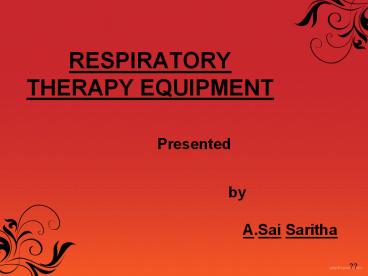Respiratory Therapy equipment - PowerPoint PPT Presentation
Title:
Respiratory Therapy equipment
Description:
Respiratory therapy works as physician extenders to evaluate, treat, and care for patients with lung and circulatory disorders – PowerPoint PPT presentation
Number of Views:1885
Updated: 13 February 2016
Slides: 15
Provided by:
kls143
Category:
Medicine, Science & Technology
Tags:
Title: Respiratory Therapy equipment
1
RESPIRATORY THERAPY EQUIPMENT
Presented
by
A.Sai Saritha
??
2
Master View -
- Introduction of Respiratory therapy equipment
- Nebulizers
- Humidifiers
- Aspirators
- Inhalators
- Respirator Ventilators
- Summary
??
3
INTRODUCTION
- Respiratory therapy is used in the diagnosis,
treatment, management and care of patients
cardiopulmonary problems. - Increasing numbers of people suffering from
respiratory diseases need complex treatment and
rehabilitation, creating a need for specialists
to assist doctors and nurses. - As a result, respiratory therapists, also known
as respiratory care practitioners, have become an
essential part of the healthcare team.
Respiratory therapists work under the direction
of physicians and follow their prescriptions for
treating patients. - Their duties range from giving temporary relief
to persons with asthma, pulmonary edema, or
emphysema to giving emergency care for
asphyxiation, heart failure, stroke, drowning or
shock. - Respiratory therapists are among the first
persons called to work with doctors and other
specialists to give treatments for acute
respiratory conditions, head injuries and drug
poisoning.
??
4
Respiratory Therapy Equipments
??
5
NEBULIZER
- You may receive medicine through a nebulizer
treatment, also called a breathing treatment or
aerosol treatment. - A nebulizer changes liquid medicine into a fine
mist to let you breathe it into your airways. - Most often the breathing treatments are given to
help you breathe easier. - How often you have a treatment depends on how
short of breath you are, the amount of wheezing
you have and the type of medicine you take.
??
6
Nebulizers Types
- Nebulizers are two types. They are
- (b)
- Electrical Nebulizer
Pneumatic
Nebulizer
??
7
HUMIDIFIERS
- During inspiration, well - vascularized mucous
membranes inside the nose and mouth released
moisture to passing respiratory gas is called
Humidifiers. - Humidifiers are currently available for this
purpose are Active Passive.
??
8
ASPIRATORS
- The purpose of aspirator for use in hospitals,
clinics, physicians offices, nursing home
facilities and home care. This durable unit meets
the need for controlled vacuum regulation up to
635 mm Hg of vacuum with a flow rate of 40 lpm at
open flow. - The aspirator has a high-impact plastic housing
and powerful rotary vane pump, reduced operating
noise level, and weighs less than 15 pounds. Each
unit comes with either a 1500 ml disposable
canister or a 1200 ml reusable glass bottle, a
suction tubing kit, and three hydrophobic
bacteria filters.
??
9
INHALATORS
- A metered dose inhaler (MDI) is a handheld
aerosol device that uses a propellant to deliver
the therapeutic agent. MDIs include a pressurized
metal canister that contains the following - Pharmacological agent in suspension or solution.
- Surfactant
- Propellant
- Metering valve
- The canister is housed in a plastic sleeve that
- has a mouthpiece for drug delivery.
??
10
REASPIRATION
VENTILATORS
- Respiration -
- Respiration are classified into two kinds of
Respirations. - The diffusion of oxygen and carbon dioxide that
takes place between the alveoli and circulating
blood is called as Pulmonary Respiration. - The exchange of oxygen and carbon dioxide
between cells and circulating blood is called as
Cellular Respiration - Similarly both respirations are called breathing.
??
11
Ventilators -
The patient is not breathing or that his
breathing is inadequate, you will need to provide
artificial ventilation.
Ventilation is the breathing of air or oxygen.
Artificial ventilation, also called positive
pressure ventilation, is forcing air or oxygen
into the lungs when a patient has stopped
breathing or has inadequate breathing.
??
12
SUMMARY
- Respiratory therapy works as physician
extenders to evaluate, treat, and care for
patients with lung and circulatory disorders.
??
13
THANK YOU
??
14
?
Any Queries
??

